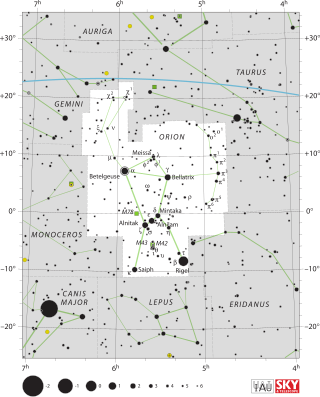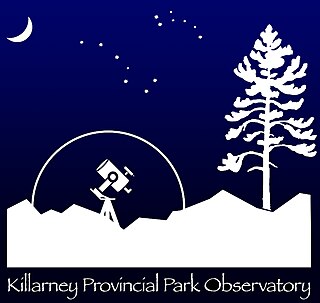
A constellation is an area on the celestial sphere in which a group of visible stars forms a perceived pattern or outline, typically representing an animal, mythological subject, or inanimate object.

Astronomy is the oldest of the natural sciences, dating back to antiquity, with its origins in the religious, mythological, cosmological, calendrical, and astrological beliefs and practices of prehistory: vestiges of these are still found in astrology, a discipline long interwoven with public and governmental astronomy. It was not completely separated in Europe during the Copernican Revolution starting in 1543. In some cultures, astronomical data was used for astrological prognostication.

Polaris is a star in the northern circumpolar constellation of Ursa Minor. It is designated α Ursae Minoris and is commonly called the North Star or Pole Star. With an apparent magnitude that fluctuates around 1.98, it is the brightest star in the constellation and is readily visible to the naked eye at night. The position of the star lies less than 1° away from the north celestial pole, making it the current northern pole star. The stable position of the star in the Northern Sky makes it useful for navigation.

A star catalogue is an astronomical catalogue that lists stars. In astronomy, many stars are referred to simply by catalogue numbers. There are a great many different star catalogues which have been produced for different purposes over the years, and this article covers only some of the more frequently quoted ones. Star catalogues were compiled by many different ancient people, including the Babylonians, Greeks, Chinese, Persians, and Arabs. They were sometimes accompanied by a star chart for illustration. Most modern catalogues are available in electronic format and can be freely downloaded from space agencies' data centres. The largest is being compiled from the spacecraft Gaia and thus far has over a billion stars.

Taurus is one of the constellations of the zodiac and is located in the northern celestial hemisphere. Taurus is a large and prominent constellation in the Northern Hemisphere's winter sky. It is one of the oldest constellations, dating back to the Early Bronze Age at least, when it marked the location of the Sun during the spring equinox. Its importance to the agricultural calendar influenced various bull figures in the mythologies of Ancient Sumer, Akkad, Assyria, Babylon, Egypt, Greece, and Rome. Its old astronomical symbol is (♉︎), which resembles a bull's head.

Orion is a constellation which is visible from most parts of the world. As well as being one of the 88 modern constellations, it was one of the 48 constellations listed by the 2nd-century astronomer Ptolemy. It is named for a hunter in Greek mythology.

The Book of Fixed Stars is an astronomical text written by Abd al-Rahman al-Sufi (Azophi) around 964. Following the translation movement in the 9th century AD, the book was written in Arabic, the common language for scholars across the vast Islamic territories, although the author himself was Persian. It was an attempt to create a synthesis of the comprehensive star catalogue in Ptolemy’s Almagest with the indigenous Arabic astronomical traditions on the constellations. The original manuscript no longer survives as an autograph, however, the importance of tradition and the practice of diligence central to Islamic manuscript tradition have ensured the survival of the Book of Stars in later-made copies.

Babylonian astronomy was the study or recording of celestial objects during the early history of Mesopotamia. The numeral system used, sexagesimal, was based on sixty, as opposed to ten in the modern decimal system. This system simplified the calculating and recording of unusually great and small numbers.
Australian Aboriginal astronomy has been passed down orally, through ceremonies, and in their artwork of many kinds. The astronomical systems passed down thus show a depth of understanding of the movement of celestial objects which allowed them to use them as a practical means for creating calendars and for navigating across the continent and waters of Australia. There is a diversity of astronomical traditions in Australia, each with its own particular expression of cosmology. However, there appear to be common themes and systems between the groups. Due to the long history of Australian Aboriginal astronomy, the Aboriginal peoples have been described as "world's first astronomers" on several occasions.

High visibility of the star cluster Pleiades in the night sky and its position along the ecliptic has given it importance in many cultures, ancient and modern. Its heliacal rising, which moves through the seasons over millennia was nonetheless a date of folklore or ritual for various ancestral groups, so too its yearly heliacal setting.
Anthony Francis Aveni is an American academic anthropologist, astronomer, and author, noted in particular for his extensive publications and contributions to the field of archaeoastronomy. With an academic career spanning over four decades, Aveni is recognized for his influence on the development of archaeoastronomy as a discipline in the latter 20th century. He has specialized in the study of ancient astronomical practices in the Americas, and is one of the founders of research into the historical astronomy of pre-Columbian Mesoamerican cultures. He held an endowed chair as the Russell Colgate Distinguished University Professor of Astronomy and Anthropology and Native American Studies at Colgate University, in Hamilton, New York, where he is now an emeritus professor.

Two-spirit is a contemporary pan-Indian umbrella term used by some Indigenous North Americans to describe Native people who fulfill a traditional third-gender social role in their communities.
The worship of heavenly bodies is the veneration of stars, the planets, or other astronomical objects as deities, or the association of deities with heavenly bodies. In anthropological literature these systems of practice may be referred to as astral cults.

The Killarney Provincial Park Observatory is an astronomical observatory located at the George Lake Campground of Killarney Provincial Park . The Observatory is operated by Ontario Parks and houses two observatory buildings. The original facility contains a 10" telescope with solar filter, ideal for nighttime as well as daytime viewing of the Sun. The newer facility contains a 16" fully automated telescope with a 5" refractor and is ideal for research, astrophotography and public use. The telescopes are available for Discovery programs as well as private sign-out (self-use) by interested visitors.
Robert P. King, born August 9, 1953, is an American photographer, writer, and an amateur astronomer. He publishes an astronomy blog called Astro Bob which is "widely read and respected" according to astronomer Bob Mizon.
Jarita Charmian Holbrook is an American astronomer and associate professor of physics at the University of the Western Cape (UWC) where they are principal investigator of the Astronomy & Society group. Holbrook's work examines the relationship between humans and the night sky, and they have produced scientific publications on cultural astronomy, starburst galaxies, and star formation regions.
Wilfred Buck is a science facilitator at the Manitoba First Nations Education Resource Centre and an Indigenous star lore expert. A member of the Opaskwayak Cree Nation, Buck is known as "the star guy" due to his knowledge of First Nations astronomy. He has researched and consulted with elders to learn more about the astronomical knowledge of Cree, Ojibway, and Lakota peoples.
Indigenous astronomy is the name given to the use and study of astronomical subjects and their movements by indigenous groups. This field encompasses culture, traditional knowledge, and astronomy. Astronomy has been practised by indigenous groups to create astronomical calendars which inform on weather, navigation, migration, agriculture, and ecology. Alongside calendric uses, constellations have names and stories that inform ceremony and social structures holding specific and deep cultural meanings for respective indigenous groups.

Bdóte is a significant Dakota sacred landscape where the Minnesota and Mississippi Rivers meet, encompassing Pike Island, Fort Snelling, Coldwater Spring, Indian Mounds Park, and surrounding areas in present-day Minneapolis and Saint Paul, Minnesota, United States. In Dakota geographic memory, it is a single contiguous area not delineated by any contemporary areas' borders. According to Dakota oral tradition, it is the site of creation; the interconnectedness between the rivers, earth, and sky are important to the Dakota worldview and the site maintains its significance to the Dakota people.











